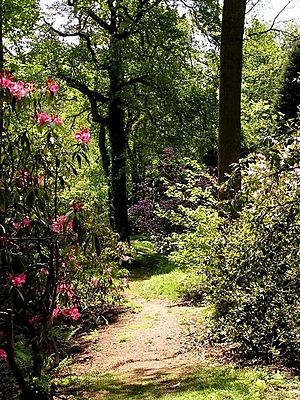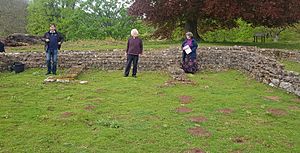Lydney Park facts for kids
Quick facts for kids Lydney Park |
|
|---|---|

Lydney Park Gardens
|
|
| Location | Lydney, Gloucestershire, England |
| Lua error in Module:Location_map at line 420: attempt to index field 'wikibase' (a nil value). | |
Lydney Park is a large country estate in Gloucestershire, England. It has a beautiful old house called Lydney House, lovely gardens, and amazing ancient Roman ruins. The estate is located near the town of Lydney in the Forest of Dean area.
Contents
Lydney House and Its Gardens
Lydney Park has been owned by the same family, the Bathurst family, since 1719. That's over 300 years! The first family member to buy it was Benjamin Bathurst.
Building a New House
The original house at Lydney Park was near the main road. It had a huge park behind it where deer used to live. In 1875, a new house was built in the middle of this deer park. This new house had great views of the River Severn. The old house was taken down, but some parts of it are still used today by a craft center.
Gardens Through Time
The gardens you see today were mostly created after 1950 by the second Viscount Bledisloe and his family. A designer named Betty Fairfax Horsfall also helped make many areas look beautiful.
The gardens have a special woodland area in a hidden valley. Here, you can find many different flowering trees and bushes like magnolias, rhododendrons, and azaleas. There's also a paved area above the gardens and formal sections that are very popular in the spring when the daffodils bloom.
The gardens are private, but they are open to visitors on certain days of the year. Lydney House also has a museum. It displays items found at the Roman site and things collected from New Zealand by the first Viscount Bledisloe.
Ancient Roman Discoveries
Lydney Park is famous for its ancient ruins. Long ago, during the British Iron Age, there was a large fort here called Lydney Camp. It covered about 4.5 acres.
Roman Iron Mines
Later, the Romans came to this area. Around the 3rd century AD, they dug for iron ore here. However, they seemed to give up because the mines weren't very productive. You can still see open-pit iron mines, called scowles, and tunnels throughout the hill today.
The Roman Temple of Nodens
In the late 4th century, the Romans built a special temple at Lydney Park. It was dedicated to Nodens, a Celtic god. This god's name is also found in old Irish and Welsh stories. The name Lydney itself comes from Lludd, another form of Nodens's name.
Many small statues of dogs were found at the temple. This suggests it was a healing shrine. Dogs were often linked with places of healing, and they might have been kept there to lick wounds.
The temple had an unusual design. It was rectangular, not square like most Roman temples. The main part of the temple, called the sanctuary or cella, had three rooms separated by stone walls. The original walls of the cella had arches, but they collapsed because of a problem with the rock underneath. So, the temple was rebuilt with solid walls.
There was also a mosaic floor decorated with fish. An inscription on the mosaic mentioned 'Victorinus the Interpreter', who might have been someone who explained dreams. Next to the temple, there was a large guest house with a courtyard, a long building for sleeping, and a fancy bathhouse.
Archaeological Digs
Archaeologists Tessa Wheeler and her husband Mortimer Wheeler dug at the site in 1928 and 1929. More excavations happened in 1980 and 1981. During these digs, they found many interesting things, including a collection of fake Roman coins. These coins were first thought to be from the 5th century, but now experts believe they are from the 4th century. The report about the excavations even included a section written by the famous author J. R. R. Tolkien, who wrote "The Lord of the Rings."
See also
 In Spanish: Lydney Park para niños
In Spanish: Lydney Park para niños


